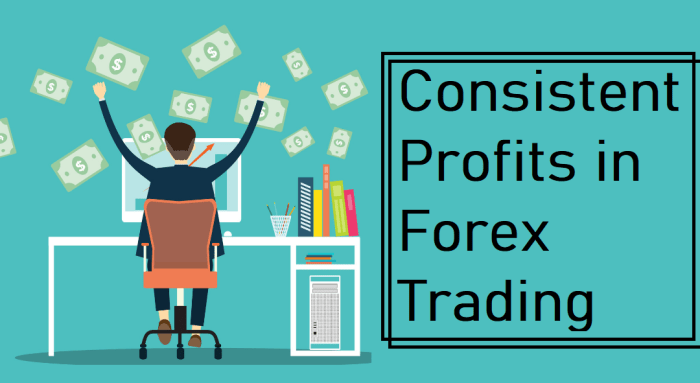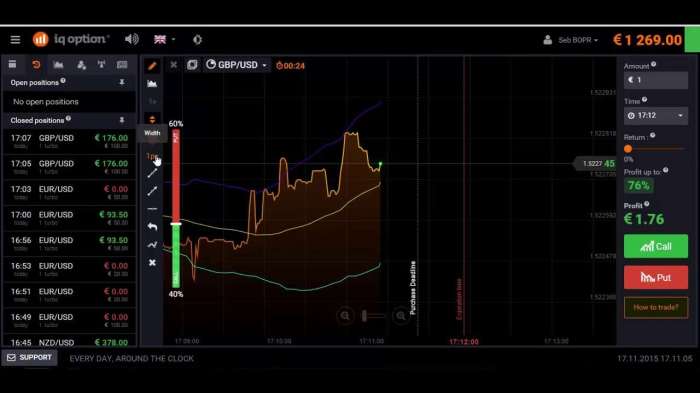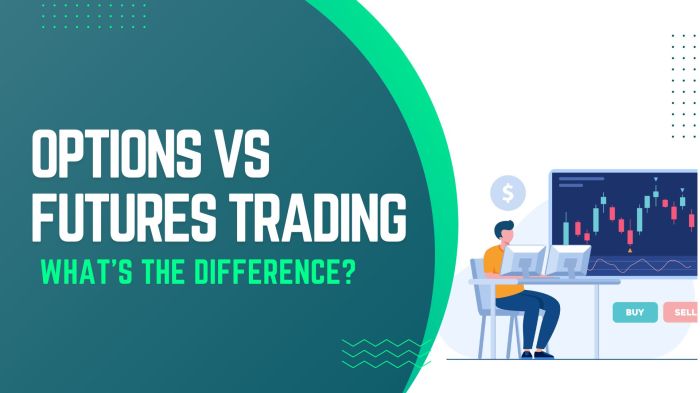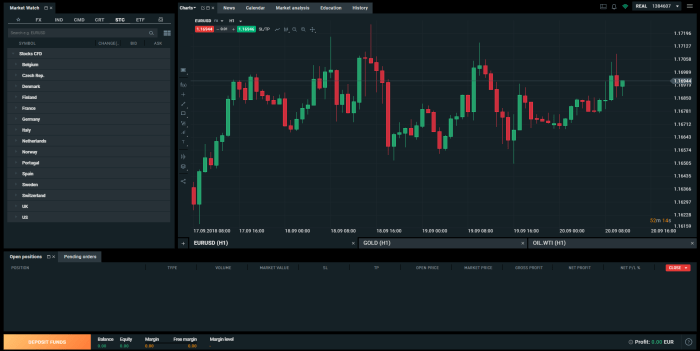
Forex trading profit: It’s the holy grail, right? The dream of turning a few clicks into a hefty sum. But let’s be real, it’s not all rainbows and unicorns. This isn’t some get-rich-quick scheme; it’s a market fueled by global economics, political shifts, and a dash of pure speculation. Understanding how forex trading profit works, from calculating pips to navigating market volatility, is key to even having a shot at success. Get ready to dive into the nitty-gritty.
We’ll break down the crucial components: leverage, spread, and pip value, showing you exactly how they influence your bottom line. We’ll explore various trading styles – scalping, day trading, swing trading – comparing their risk and reward profiles. Crucially, we’ll emphasize the importance of risk management, because even the best strategies can go south without a solid plan. We’ll equip you with strategies for enhancing your profit potential, from technical analysis to psychological discipline.
Defining Forex Trading Profit
Forex trading, at its core, is about making money from fluctuations in exchange rates. But understanding how that profit is actually generated requires a grasp of several key concepts. It’s not just about buying low and selling high; it’s a nuanced dance of pips, leverage, and spreads.
Forex Profit Components
Profit in forex trading is determined by several interacting factors. Understanding these components is crucial for successful trading.
Pip Value: A pip (point in percentage) is the smallest price movement in a currency pair. For most pairs, it’s the fourth decimal place (e.g., 0.0001). The pip value represents the monetary value of that movement, and it varies based on the lot size (the amount of currency you’re trading) and the base currency of your account. A standard lot is typically 100,000 units of the base currency. So, a one-pip movement on a EUR/USD pair with a standard lot size and a USD-denominated account might equate to $10 (depending on the current exchange rate).
Leverage: Leverage allows you to control a larger position than your account balance would normally permit. For instance, a 1:100 leverage means you can control $100,000 with only $1,000 in your account. While leverage amplifies potential profits, it also magnifies potential losses, so it’s a double-edged sword.
Spread: The spread is the difference between the bid price (the price at which you can sell a currency pair) and the ask price (the price at which you can buy). Brokers profit from the spread, and it represents a cost of trading. A wider spread eats into your potential profit.
Discover more by delving into free forex trading charts further.
Calculating Forex Trading Profit
Calculating forex profits depends on the direction of your trade (long or short) and the size of the price movement.
Long Position (Buy): If you buy a currency pair and the price rises, your profit is calculated as: (Sell Price – Buy Price) x Lot Size x Pip Value.
Short Position (Sell): If you sell a currency pair and the price falls, your profit is calculated as: (Buy Price – Sell Price) x Lot Size x Pip Value.
Profit = (Closing Price – Opening Price) x Lot Size x Pip Value
Remember that the actual profit might be slightly lower due to the spread and any commissions charged by your broker.
Remember to click live forex trading graphs to understand more comprehensive aspects of the live forex trading graphs topic.
Profit Display on Trading Platforms
Different platforms display profit in various ways, but the underlying calculation remains consistent.
Here are a few examples:
| Platform Name | Profit Display Method | Example Calculation | Currency |
|---|---|---|---|
| MetaTrader 4 (MT4) | Shows profit/loss in the “Equity” field and graphically on charts. | Bought 1 lot EUR/USD at 1.1000, sold at 1.1050. Profit: (1.1050 – 1.1000) x 100,000 x 0.0001 = $50 (excluding spread) | USD |
| cTrader | Displays P/L directly on the open trade ticket and in the “Trades” tab. | Sold 0.5 lots GBP/USD at 1.3000, bought back at 1.2950. Profit: (1.3000 – 1.2950) x 50,000 x 0.0001 = $25 (excluding spread) | USD |
| TradingView (with broker integration) | Shows P/L on the chart and in the order details. | Bought 1 lot USD/JPY at 110.00, sold at 110.50. Profit: (110.50 – 110.00) x 100,000 x 0.01 = $500 (excluding spread, pip value is different for JPY pairs) | JPY |
| Oanda | Displays profit/loss in the account statement and trade history. | Bought 2 lots AUD/USD at 0.7000, sold at 0.7100. Profit: (0.7100 – 0.7000) x 200,000 x 0.0001 = $200 (excluding spread) | USD |
Factors Influencing Forex Trading Profit
Forex trading, while potentially lucrative, is a complex endeavor heavily influenced by a multitude of factors. Understanding these factors is crucial for developing a robust trading strategy and maximizing your chances of profitability. Ignoring these influences can lead to significant losses, highlighting the importance of thorough market analysis and risk management.
Economic Indicators
Economic indicators provide a snapshot of a country’s economic health, directly impacting its currency’s value. Strong economic data, such as a rise in GDP or a decrease in unemployment, generally strengthens a currency, while weak data can lead to a decline. For instance, a surprise increase in inflation in the United States might cause the US dollar to appreciate against other currencies as investors seek a safe haven. Conversely, a lower-than-expected inflation rate might weaken the dollar. Traders closely monitor indicators like inflation rates (CPI, PPI), interest rates (set by central banks), employment data (non-farm payrolls), and manufacturing output (PMI) to anticipate currency movements.
Geopolitical Events
Geopolitical events, including wars, political instability, and international relations, can significantly impact forex markets. Uncertainty often leads to increased volatility and capital flight, affecting currency values. For example, a major geopolitical crisis might cause investors to move their money into safe-haven currencies like the Japanese yen or Swiss franc, causing these currencies to appreciate while others depreciate. Traders need to stay informed about global events and their potential impact on currency pairs they’re trading.
Market Sentiment
Market sentiment, the overall feeling or attitude of traders towards a particular currency or market, plays a crucial role in price movements. Positive sentiment, driven by factors like positive economic news or investor confidence, can push prices higher, while negative sentiment can lead to price declines. This sentiment is often reflected in news headlines, analyst reports, and social media discussions. Understanding and interpreting market sentiment can be a powerful tool for predicting price trends, although it’s important to remember that sentiment can be highly volatile and subject to rapid shifts.
Trading Strategies
The choice of trading strategy significantly impacts profitability. A well-defined strategy, based on thorough market analysis and risk management principles, is essential for consistent success. This includes defining entry and exit points, setting stop-loss orders to limit potential losses, and using appropriate leverage to manage risk. Strategies might incorporate technical analysis (chart patterns, indicators) or fundamental analysis (economic data, geopolitical events) or a combination of both. The optimal strategy depends on individual risk tolerance, trading style, and market conditions.
Trading Styles and Profit Potential
Different trading styles offer varying levels of risk and potential for profit.
Scalping involves holding positions for very short periods (seconds to minutes), aiming for small profits from numerous trades. It requires quick reflexes, precise execution, and low transaction costs.
Day trading involves holding positions throughout a trading day, closing all positions before the market closes. It requires close monitoring of market movements and a good understanding of technical analysis.
Swing trading involves holding positions for several days or weeks, aiming to capture larger price swings. It requires patience and the ability to identify longer-term trends.
Long-term investing involves holding positions for months or even years, capitalizing on long-term economic trends and fundamental analysis. It necessitates a long-term perspective and a tolerance for market fluctuations. Each style has its own risk-reward profile; scalping offers high frequency but potentially smaller returns while long-term investing offers the potential for larger returns but requires greater patience and risk tolerance.
Risk Management and Forex Trading Profit
Consistent profitability in forex trading isn’t about luck; it’s about strategy, discipline, and, most importantly, robust risk management. Without a well-defined risk management plan, even the most brilliant trading strategies can lead to devastating losses. Think of it as building a skyscraper – you need a solid foundation to withstand any storm. Ignoring risk management is like building on shifting sand; one unexpected market movement can bring the whole thing crashing down.
Risk management in forex trading involves implementing strategies to limit potential losses and protect your capital. It’s about preserving your ability to trade another day, another week, another year. This isn’t about avoiding losses entirely—losses are inevitable—but about controlling their size and frequency so they don’t wipe out your account. It’s about turning those inevitable losses into learning experiences rather than financial catastrophes.
Stop-Loss Orders and Take-Profit Orders
Stop-loss orders and take-profit orders are the cornerstones of effective risk management. A stop-loss order automatically closes a trade when the price reaches a predetermined level, limiting potential losses. A take-profit order automatically closes a trade when the price reaches a predetermined level, securing profits. Setting these orders before entering a trade removes emotion from the equation, ensuring you stick to your plan even when market conditions become stressful. Imagine a scenario where you’re watching a trade move against you, your heart pounding. A pre-set stop-loss order prevents impulsive decisions driven by fear or greed, protecting your capital. Similarly, a take-profit order ensures you lock in profits at your desired level, avoiding the temptation to hold onto a winning trade for too long and potentially giving back those gains.
Position Sizing
Position sizing determines how much capital you allocate to each trade. It’s about carefully calculating the appropriate amount to risk on any given trade, based on your overall account balance and risk tolerance. A common approach is to risk only a small percentage of your account balance (e.g., 1-2%) on any single trade. This means that even if a trade goes completely against you, the loss will be manageable, and you’ll still have a significant portion of your capital remaining to continue trading. For instance, with a $10,000 account and a 1% risk tolerance, the maximum loss you’d accept on a single trade is $100. This discipline prevents a single bad trade from wiping out your entire account.
Examples of Effective Risk Management, Forex trading profit
Consider a trader who uses a 2% risk-per-trade strategy. They enter a trade with a stop-loss order at a level that would result in a 2% loss if triggered. The market moves against them, hitting the stop-loss, resulting in a $200 loss on a $10,000 account. While disappointing, this loss is manageable and doesn’t significantly impact their overall trading capital. They can learn from the mistake, adjust their strategy, and continue trading without crippling their account. In contrast, a trader without a stop-loss might watch their position plummet, leading to a much larger, potentially catastrophic loss, possibly wiping out their account entirely. Another example: A trader sets a take-profit order at a level representing a 3:1 risk-reward ratio. The trade hits the take-profit target, securing a profit three times larger than their potential loss. This demonstrates the power of risk management in maximizing profits while minimizing losses. The consistent application of stop-loss and take-profit orders, combined with prudent position sizing, allows for sustained profitability even amidst losing trades.
Strategies for Enhancing Forex Trading Profit

Boosting your forex trading profits requires a strategic approach that blends understanding market dynamics with disciplined execution. While no strategy guarantees riches, implementing effective techniques can significantly improve your chances of success. This section delves into key strategies to enhance your profitability.
Technical Analysis Indicators and Their Application
Technical analysis indicators offer valuable insights into price trends and momentum, potentially improving trading decisions. However, it’s crucial to understand both their benefits and limitations. Over-reliance on any single indicator can lead to inaccurate signals and losses.
- Moving Averages: Moving averages smooth out price fluctuations, identifying potential trend changes. Simple moving averages (SMA) and exponential moving averages (EMA) are commonly used. SMAs react slower to price changes than EMAs. A crossover of a fast EMA over a slow SMA can signal a buy signal, while the opposite indicates a potential sell signal. However, moving averages can generate false signals in ranging markets.
- Relative Strength Index (RSI): RSI measures the magnitude of recent price changes to evaluate overbought or oversold conditions. Readings above 70 often suggest an overbought market, potentially indicating a price reversal, while readings below 30 suggest an oversold market, hinting at a potential upward trend. However, RSI can also produce false signals, particularly in strong trends.
- Moving Average Convergence Divergence (MACD): MACD is a trend-following momentum indicator that shows the relationship between two moving averages. A bullish crossover (MACD line crossing above the signal line) can be a buy signal, and a bearish crossover (MACD line crossing below the signal line) a sell signal. Divergences between the MACD and price action can also provide valuable insights. However, MACD can generate whipsaws in sideways markets.
The Mean Reversion Strategy
This strategy capitalizes on the tendency of prices to revert to their mean or average. It involves identifying overbought or oversold conditions and placing trades expecting a price correction.
- Identify an Overbought or Oversold Condition: Use an indicator like the RSI. For example, an RSI reading above 70 on the EUR/USD pair suggests the pair is overbought.
- Set Entry and Stop-Loss Orders: Place a sell order slightly below the current price, aiming to profit from a price correction. A stop-loss order should be placed above the recent high to limit potential losses if the price continues to rise.
- Determine the Take-Profit Level: The take-profit level is typically set based on the anticipated price correction. For example, if the RSI suggests an overbought condition, a take-profit level could be set at the 50 RSI level or a support level identified on the chart.
- Monitor and Manage the Trade: Once the trade is entered, monitor the price action. If the price moves against your position, your stop-loss order will limit your losses. If the price moves in your favor and reaches your take-profit level, close the trade to secure profits.
Hypothetical Example: Let’s say the EUR/USD pair’s RSI reaches 75. You place a sell order at 1.1050 with a stop-loss at 1.1070 and a take-profit at 1.0980. If the price falls to 1.0980, you secure a profit. If it rises to 1.1070, your stop-loss limits your loss.
Backtesting a Forex Trading Strategy
Backtesting involves applying a trading strategy to historical data to assess its potential profitability and risk. This helps refine the strategy and identify potential weaknesses before risking real capital.
- Gather Historical Data: Obtain reliable historical forex price data covering a sufficient period (at least several years).
- Define Entry and Exit Rules: Clearly Artikel your strategy’s entry and exit signals, including any indicators used.
- Simulate Trades: Apply your strategy to the historical data, simulating trades based on your entry and exit rules. Record the results of each trade (profit or loss).
- Analyze Results: Calculate key performance metrics such as win rate, average win/loss, maximum drawdown, and overall profitability. Analyze the results to identify areas for improvement in your strategy.
- Refine and Iterate: Based on the backtesting results, refine your strategy, adjusting parameters or rules as needed. Repeat the backtesting process to assess the effectiveness of your adjustments.
Psychological Aspects of Forex Trading Profit
Forex trading isn’t just about charts and indicators; it’s a deeply psychological game. Your emotional state significantly impacts your decision-making, potentially turning profitable trades into losses and vice-versa. Understanding and managing these psychological factors is crucial for consistent success. Ignoring the emotional side of trading is like driving a car blindfolded – you might get lucky, but it’s unlikely to end well.
Success in forex trading hinges on your ability to maintain emotional discipline. The market’s volatility and the constant pressure to make the “right” move can trigger powerful emotional responses, often leading to impulsive and ultimately costly actions. This section explores common psychological biases and provides strategies to navigate them effectively.
Common Psychological Biases in Forex Trading
Emotional responses in forex trading often manifest as cognitive biases – systematic errors in thinking that affect our judgment. These biases can significantly impact trading decisions and profitability. For instance, overconfidence can lead to taking on excessive risk, while fear can cause traders to miss out on profitable opportunities or prematurely exit winning trades. Greed, on the other hand, might tempt traders to hold onto losing positions hoping for a miraculous recovery, resulting in further losses.
Strategies for Maintaining Emotional Discipline
Maintaining emotional discipline in forex trading requires conscious effort and the development of specific strategies. One effective approach is to develop a robust trading plan that Artikels clear entry and exit rules, risk management parameters, and position sizing. Sticking to this plan, regardless of emotional impulses, is paramount. Furthermore, practicing mindfulness techniques, such as meditation or deep breathing exercises, can help to calm the mind and improve focus, enabling better decision-making under pressure. Regularly reviewing your trading journal (discussed below) can also help identify emotional triggers and develop strategies to manage them. Remember, trading should be a methodical process, not an emotional rollercoaster.
The Importance of a Trading Journal
A trading journal isn’t just a record of your trades; it’s a powerful tool for self-reflection and improvement. By meticulously documenting each trade – including entry and exit points, rationale, emotions felt during the trade, and the overall outcome – you create a valuable resource for identifying patterns in your behavior. For example, you might notice a tendency to overtrade when feeling stressed or to hold onto losing positions out of stubbornness. This self-awareness is crucial for developing strategies to mitigate these behavioral patterns and improve your trading performance. The journal also allows you to track your progress over time, celebrate successes, and learn from mistakes, fostering a positive and constructive trading mindset. Consider it your personal guide to mastering the psychological aspects of forex trading.
Illustrative Examples of Profitable Forex Trades

Profitable forex trading isn’t about luck; it’s about a well-defined strategy, disciplined risk management, and a keen understanding of market dynamics. Let’s dissect a hypothetical trade to illustrate these principles.
EUR/USD Long Position
This example focuses on a long position in the EUR/USD currency pair. Our analysis suggests a bullish trend is developing, supported by both fundamental and technical indicators.
We observed a period of consolidation followed by a breakout above a key resistance level. Imagine a candlestick chart showing a clear upward trend. The price had been consolidating in a range between 1.1000 and 1.1100 for several days. Then, a strong bullish candlestick, a long green candle, decisively broke above 1.1100, accompanied by increased trading volume. This breakout signaled a potential continuation of the uptrend. Furthermore, the Relative Strength Index (RSI) was showing an oversold condition before the breakout, further confirming the potential for a price increase. The Moving Average Convergence Divergence (MACD) indicator also showed a bullish crossover, reinforcing the signal.
Risk Management and Trade Execution
Our risk management plan involved using a 1:2 risk-reward ratio. This means that for every $100 risked, we aimed for a $200 profit. We placed our stop-loss order below the previous swing low at 1.1080, thus limiting potential losses to 20 pips. Our take-profit order was placed at 1.1200, representing a target of 40 pips. This risk-reward ratio helps to manage potential losses while maximizing potential gains. The trade was entered at 1.1105.
Profit Calculation
Let’s assume a trade size of 10,000 units (a standard lot) with a leverage of 1:100. The pip value for a standard lot in EUR/USD is typically around $10. The spread, the difference between the bid and ask price, is assumed to be 1 pip.
The profit calculation is as follows:
Profit = (Take Profit Price – Entry Price – Spread) x Lot Size x Pip Value
Profit = (1.1200 – 1.1105 – 0.0001) x 10,000 x $10 = $940
Therefore, this trade generated a profit of $940 before considering any commissions or fees. The 1:2 risk-reward ratio ensured that the potential profit significantly outweighed the potential loss. Remember that leverage magnifies both profits and losses.
Ultimate Conclusion

So, the path to forex trading profit isn’t paved with gold, but with knowledge, discipline, and a healthy dose of realism. It’s about understanding the market forces at play, mastering effective trading strategies, and, most importantly, managing risk. While the allure of quick riches is tempting, sustainable success in forex trading comes from consistent effort, meticulous planning, and a commitment to continuous learning. Ready to take the plunge? Let’s get started!




